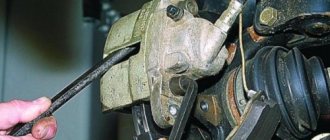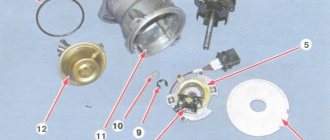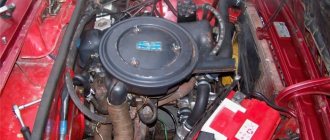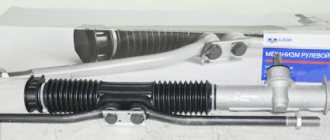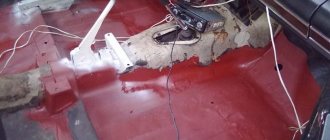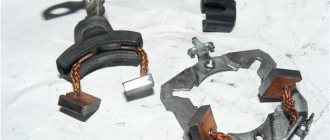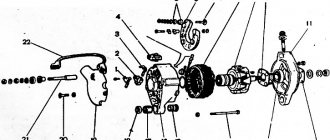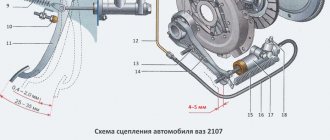Why is there a weak spark on the spark plugs?
The spark can be weak for various reasons. The main ones are malfunctions:
- Spark plugs.
- Ignition coils.
- Battery.
- High voltage wires.
- Low voltage circuits.
- Electronic control unit.
- Distributor.
Sometimes the problem can occur due to loose connections between the wires and the vehicle's electronic equipment. Problems sometimes arise for other reasons. But the first thing you should do is check the engine compartment for moisture. Often it is enough to wipe them with a rag to restore the functionality of the candles. But on heavily used cars with high mileage, increasing spark power without some modifications is not always possible, even if the above parts and assemblies are in full service.
Faulty spark plug
Ignition coil device
To test this system, you will need an electrical device such as a multimeter, as well as screwdrivers with different heads and insulated pliers for working under voltage. It is necessary to observe safety precautions when working with the ignition system, because... high voltage electric current flows in the circuit. It is recommended to have rubber gloves or insulated pliers.
The schematic diagram of the VAZ 2106 ignition coil is located here. The figure shows how the ignition coil is connected in the standard version.
The ignition coil, the price of which is acceptable for most Russian motorists, has the nomenclature code 8352.12. and is an oil-filled tank with an open-type magnetic wire.
The standard ignition coil of the “six”, which is easy to buy at any specialized auto parts store, is equipped with 3 contact terminals: “B”, “K” and an output for the central high voltage wire. The ignition coil is connected in the following way: the positive wire of the battery is connected to terminal “B” through the ignition switch contact. Output “K” is connected to the output contacts of both windings of the ignition coils and the negative wire of the battery through the switch.
The high voltage output is connected to another contact of the secondary winding and a high voltage wire contact leading to the breaker distribution element, which, with the rotational movement of the slider, distributes the high voltage current to the spark plugs.
Differences in testing methods for carburetor and injection internal combustion engines
To determine the malfunction, you need to check all the spark plugs individually. Often, an improvement in the spark occurs when replacing a set of spark plugs. But sometimes the reason may be different. At the same time, all SZs break down at the same time infrequently.
Checking these elements for cars with carburetor and injection engines is different. For the first type of car, it is enough to unscrew the spark plug, connect the wire and touch the ground with the metal part. Turn on the car ignition.
Checking the spark plug using wires, typical for cars with a carburetor engine
This method is not suitable for vehicles with fuel injection engines. These cars are equipped with many electronic devices. They may fail during such a test. Therefore, it is recommended to use a multimeter to diagnose the condition of the spark plugs. It will allow you to safely and accurately identify a faulty SZ.
Checking the spark plug with a multimeter, typical for cars with an injection engine
No spark - checking the ignition module
Possible signs of ignition module failure:
- engine tripping at idle;
- drop in power, poor acceleration dynamics.
If the wires and spark plugs are ok, you need to test the ignition module. We connect one multimeter probe to the module connector, and connect the second to ground. After this we try to start the engine. If the device display shows a value of about 12V, the module is working.
What to do
If the engine runs or starts poorly, motorists are interested in how to strengthen the spark on the spark plugs. First, you need to establish the cause of the breakdown by checking the previously mentioned components and elements using a multimeter and visual inspection. Many faults can be seen by eye.
Often, a simple replacement of spark plugs or glow plugs can help improve the spark (depending on the type of internal combustion engine (petrol or diesel). It is advisable to buy elements from well-known manufacturers in the mid-price category, beware of counterfeits. Faulty spark plugs can often be identified by their appearance. In addition, their replacement is required with the following symptoms:
- Engine tripping.
- Poor starting of the power plant, especially in cold or wet weather.
- White smoke from the exhaust pipe of a car with a diesel engine.
- Reduced vehicle dynamics.
- Increased fuel consumption.
Comparing spark plugs before replacing them
It is worth noting that sometimes similar symptoms are observed when other parts of the car fail. Therefore, if the spark plugs visually look serviceable, it is better to check other components and elements. If you were unable to determine the cause yourself or replacing the SZ did not help, it is recommended to contact a car service for professional diagnostics.
The spark power may not be enough if the ignition coil is broken or the high-voltage wires fail. Therefore, they should be tested with a multimeter. Replacing these parts often helps improve the spark.
Checking the coil with a multimeter
Increased power is often achieved by replacing the distributor. Repairing the low voltage circuit or improving the conductivity of the connection contacts often helps solve the problem. To search for an open or short circuit, use a multimeter. Often, replacing or charging the battery with a charger helps increase spark power. Everyone knows that a weak battery does not contribute to good engine starting, especially in winter. Therefore, it must be checked before the cold weather. If it is old or poorly charged, it should be replaced or charged. Recharging may also be required after the machine has been idle for a long time.
Charging the battery using a charger
But sometimes, in order to completely get rid of the problem, you only need to modify the spark plugs yourself. This is primarily relevant for owners of used domestic cars or old inexpensive foreign cars. This method is also suitable for some budget-conscious motorists. For this modification you need to purchase:
- High voltage copper wires.
- Spark booster.
- Kit for installing contactless ignition (if the car has an old contact system).
- Spark plugs without resistors.
The method consists of several stages. You don't have to do all of them. Perhaps one of the proposed solutions is enough for someone to increase the spark. Refinement is carried out according to the following algorithm:
- Install spark plugs without resistors. This should increase the amount of free energy by about 50%.
Spark plugs without resistors - Install high-voltage copper wires. This will help reduce resistance in the system. This means the spark will be stronger.
High voltage wires with copper core - Increase the distance between the electrodes on the spark plug. After this, it is advisable to test it in a pressure chamber. It is advisable to choose the longest interval at which the spark is stable. This will significantly improve engine performance and starting.
Increased distance between electrodes - Install a spark amplifier on the spark plug. This device is sold in car dealerships. It consists of two contact connections and a capacitor. One of the contacts needs to be attached to the SZ, and the other to the high-voltage wire. This will increase the temperature of the spark at the plug.
Installed spark amplifier - Install a modern contactless ignition system. It works more stable than the contact one. The latter is not used today on new cars and is found only on cars produced relatively long ago.
Contactless ignition system kit
Almost all modifications can be done independently with minimal knowledge of car repair and maintenance. But, if such tuning yourself seems difficult, it is better to contact a service station, where the problem with a weak spark will be solved by experienced specialists. True, the costs may increase several times.
Bringing the car back to life
As for why a spark disappears, everything is probably very clear. Now, it would not be amiss to consider the order of her return. The reality is that in most cases, getting the spark back is a simple matter and just involves carefully checking the broken car. To be more precise, to normalize sparking it is required:
- Firstly, check the spark on the injector using the method described above, make sure that it has disappeared, and, at least indirectly, try to determine the cause of the malfunction;
- Next, it is enough to assess the current circumstances and act based on them. As typical situations, we suggest considering solutions to the following problems:
- the spark plug is wet, the presence and strength of the spark are unimportant, the carbon deposits are correct (brick color) - wipe the part and screw it back in;
- the spark plug is wet (not always) and the carbon deposits are incorrect (white or black) - clean, dry the part and try to start the engine, if there is no result, change the spark plug and deal with problems in the fuel system (cleaning the injector, checking the ECU, etc.);
- the spark plug is wet, there is no spark at all, the color of the soot is not important - we try to change the part, if there is no result, we check the ignition system and the operation of the injector.
In principle, in theory there are no particular difficulties in repairs of this kind. Despite this, it often causes difficulties in implementation for inexperienced motorists. To solve these, you need to act in the order described above, but if something doesn’t work out, it’s better to turn to professionals at a service station. This approach to repairs will not only save time, but also guarantee trouble-free operation of the car in the future.
Perhaps this concludes the most important information on today’s issue. We hope that the material presented was useful to you and provided answers to your questions. Good luck in operating and maintaining your car!
Sources:
https://unit-car.com/diagnostika-i-remont/26-neispravnosti-sistemy-zazhiganiya.html https://etlib.ru/blog/164-net-iskry https://twokarburators.ru/propala- iskra-svecha-zazhiganiya/ https://autostuk.ru/propala-iskra-na-sveche-prichiny-kak-ispravit-poshagovaya-instrukciya.html https://swapmotor.ru/ustrojstvo-dvigatelya/net-iskry-inzhektor .html
Additional recommendations
If the engine begins to run poorly or starts, diagnostics should begin by checking the spark plugs. When disconnecting wires, you should mark them with “+” and “-” signs so as not to be confused when connecting. Even if the SZ visually looks normal, it is better to replace them and drive them for a while. If the problem persists, check the high-voltage wires, ignition coil and other system elements. Self-repair of an ECU without special knowledge and experience is impossible. Unqualified intervention in its device can lead to more significant damage and costs.
Now you know why there may be a weak spark on the candles and how to deal with this scourge with your own hands. Have you ever had problems starting the engine for this reason? Were you able to fix it yourself or did you contact a service station? What exactly helped? If you have any questions or want to share useful advice on the topic, write in the comments.
see also
Error p0351 p0352 p0353 p0354 - what does it mean
- 9 0 7k
Replacing spark plugs on a Z18XE engine
- 5 0 2k
Spark plug and coil lubricant
- 62 2 75k
Checking the ignition with an oscilloscope
- 44 0 41k
Ignition system diagnostics
- 9 2 36k
When the spark is lost, you will, of course, never start the car, and in such a situation, first of all, you need to check the ignition system.
The vehicle's ignition system plays a key role in its operation. If in case of many other malfunctions the car can be taken under its own power to the service station, then in case of problems with the ignition it is unlikely that it will be possible to start the engine at all.

